Multi-Indicator Heuristic Evaluation-Based Rapidly Exploring Random Tree Algorithm for Robot Path Planning in Complex Environments
Abstract
1. Introduction
- Sampling efficiency problem: Existing algorithms generally suffer from an uneven distribution of sampling points and insufficient sampling in key areas.
- Balance problem: Difficulty in achieving a good balance between exploration efficiency and path quality.
- Computational resource problem: Many improved methods result in significant increases in computational overhead.
- Hammersley sequence sampling: The pseudo-random sampling of traditional RRT often leads to the uneven distribution of sampling points, resulting in oversampling in some areas and undersampling in others. This study adopts the Hammersley sequence sampling technique in MIHE-RRT to ensure the uniform distribution of sampling points in the configuration space, effectively avoiding common clustering and sampling blind spots in traditional Monte Carlo sampling and significantly improving spatial exploration efficiency.
- Multi-indicator heuristic evaluation mechanism: This study proposes a comprehensive evaluation system for MIHE-RRT that achieves a dynamic balance between exploration and development by simultaneously considering three dimensions of indicators: diversity value (to avoid duplicate sampling), distance value (to optimize path length), and angle value (to ensure progress towards the goal). This effectively prevents algorithms from over-exploring
- Tree pruning algorithm: This study integrates a specialized tree pruning algorithm into MIHE-RRT to solve the common problems of redundant nodes and unnecessary turns in RRT-generated paths. Our algorithm significantly shortens path length, improves path practicality, and increases execution efficiency by optimizing node distribution and simplifying path structure.
2. MIHE-RRT
| Algorithm 1: MIHE-RRT Algorithm |
Output: Optimal path |
} : ) Until d < Error value Backtracking path Path smoothing algorithm smooths the path End for Return Optimal path |
2.1. Hammersley Sequence
- Insufficient sampling in key regions: As shown in the red area in Figure 1a, due to the uneven probability density distribution of pseudo-random sampling, the algorithm struggles to consistently generate valid candidate points in key areas such as narrow passages. This prevents the heuristic function from filtering out suitable expansion nodes, significantly reducing the algorithm’s ability to break through semi-closed regions.
- Excessive sampling in redundant regions: As shown in the blue area in Figure 1a, sampling points exhibit non-uniform clustering phenomena. This excessive sampling in redundant regions not only wastes computational resources but also affects path planning efficiency due to the reduced spatial diversity of candidate points, forming a vicious cycle of increased computational overhead and decreased solution quality.
- The first dimension adopts uniform distribution, and the equidistant selection is , where is the index of the sample, and the range is 1 to . is the number of samples.
- The second dimension employs the Van der Corput sequence with base to generate a low-variance sequence. The Van der Corput sequence transforms natural numbers into decimals within the interval [0, 1] through radix conversion and digit reversal, producing a uniformly distributed low-discrepancy sequence. The formula is as follows:
2.2. Multi-Indicator Heuristic Evaluation Mechanism
- Multi-dimensional collaborative evaluation: Existing algorithms such as Informed-RRT primarily rely on single-dimensional heuristic elliptical region sampling, while MIHE-RRT simultaneously considers three dimensions—spatial diversity, target distance, and directional angle—forming a more comprehensive evaluation system.
- Dynamic balancing mechanism: Through weight parameters (,), it achieves a dynamic balance between exploration and exploitation, solving the problem of excessive exploration in complex environments that occurs in other algorithms such as RRT.
- Integration of local and global information: The diversity value focuses on local spatial structure, the distance value guides the global target direction, and the angle value optimizes local expansion efficiency, achieving an organic integration of local and global information.
- In the sampling phase, the point set of the Hammersley sequence sampling is generated in advance.
- For each point in the point set, calculate its Euclidean distance from all nodes in the current tree to find the nearest point .
- Move a step from to to obtain a new point .
- Check whether the path from to the nearest tree node is collision-free.
- Points where collisions occur will be deleted, while non-colliding points are retained. If all points in the set collide, the process advances to the next iteration.
- After completing collision detection, the remaining points in the set will become candidate points, with a quantity of k. The multi-indicator heuristic evaluation mechanism then calculates a value for each candidate point and selects the one with the highest value as the sampling point for the current iteration.
2.2.1. Diversity Value
2.2.2. Distance Value
2.2.3. Angle Value
2.2.4. Selection of Weights for Distance Value, Angle Value, and Diversity Value
2.2.5. The Number of Points in the Point Set ()
2.3. Tree Pruning
- Beginning at the path’s start point, the algorithm attempts to establish direct connections to subsequent path points.
- Each potential straight-line connection undergoes collision detection.
- If no obstacle collisions are detected, all intermediate nodes between the connected points are eliminated.
- If a collision is detected, the last valid (collision-free) node becomes the new starting point for optimizing the remaining segments.
2.4. Computational Complexity
2.4.1. Space Complexity
- The main space requirement comes from storing the random tree structure. Each node needs to store coordinate position, parent node reference, comprehensive value, and node connections. If is the total number of nodes in the final tree, this part requires space.
- The algorithm generates 25 candidate points in each iteration using Hammersley sequence sampling. These 25 points are temporarily stored for evaluation. This is a fixed space requirement of , as the sample size remains fixed at 25 regardless of the input scale.
- For heuristic evaluation, the algorithm needs to store diversity value, distance value, and angle value for each candidate point, as well as weight parameters (,) and comprehensive evaluation scores. Since these values are calculated for a fixed number of candidate points (25), this also requires space.
- Once the algorithm finds a path, it needs to store the path. Storing the final path as a sequence of nodes and the optimized pruned path requires, in the worst case, space as the path might include all nodes in the tree.
- For collision detection, the algorithm needs to maintain a representation of obstacles in the environment and temporary variables for collision checking. The space complexity of the environment representation depends on the specific implementation but is typically , where is the number of obstacles.
2.4.2. Time Complexity
- When generating the point set during each of the 25 iterations, each step includes sampling point generation , finding the nearest neighbor , and collision detection . The overall time complexity is , which simplifies to , where represents the current number of nodes in the tree.
- In the best candidate selection phase of the algorithm, we need to select the optimal point from candidates that have passed collision detection. This process requires performing multiple operations for each candidate point: calculating its distance to the target , finding the nearest node to it in the tree , determining the relevant nodes in the local small-scale search area , and calculating various value metrics . Combining these operations, the theoretical time complexity for selecting the best candidate point is .
- In the step of generating a new node, extending the nearest node toward the sampling point based on the specified step length is a basic mathematical operation with a time complexity of .
- Finally, the algorithm adds the new node to the tree structure, which only involves the simple addition of array elements and calculation of cost values, a constant time operation with complexity .
- Therefore, the total complexity for a single iteration is . Simplified to , and since 25 and are constants, the final complexity is .
3. Experimental Simulation Results and Analysis
3.1. Preparation for Simulation Testing
3.2. Algorithm Simulation Testing
4. Conclusions and Future Directions
- Sampling strategy innovation: Compared to pseudo-random sampling used by traditional RRT, RRT*, and IBi-RRT, Hammersley sequence sampling provides theoretically superior spatial coverage characteristics; compared to the Halton sequence used by HB-RRT, the Hammersley sequence exhibits more uniform distribution properties in low-dimensional spaces. This study designed an innovative algorithm based on Hammersley sequence sampling that can generate high-quality point sets with uniform distribution and low discrepancy, providing a solid foundation for subsequent multi-indicator heuristic evaluation. By optimizing sampling point distribution, the algorithm significantly reduces redundant sampling in open areas, allowing computational resources to be allocated more rationally, thereby improving overall efficiency. Compared to traditional sampling methods, the Hammersley sequence provides more consistent spatial coverage characteristics, making the exploration process more efficient.
- Evaluation mechanism innovation: Unlike existing algorithms that rely on single evaluation metrics (such as probability thresholds or path length), the MIHE-RRT in this study introduces a three-dimensional evaluation system to achieve a comprehensive assessment of candidate points. When encountering obstacles, this study implements diversity values in the algorithm to prevent efficiency loss by avoiding excessive exploration of specific areas, enabling it to effectively bypass obstacles and escape challenging situations. This study combines distance and angle values to more purposefully guide tree growth toward the target, optimizing sampling point distribution and reducing redundant sampling in open areas. Through multi-indicator heuristic evaluation, this study achieves efficient path planning in complex regions. After generating the path, this study uses MIHE-RRT’s tree pruning algorithm to delete unnecessary nodes, thereby optimizing the global path length.
Author Contributions
Funding
Data Availability Statement
Acknowledgments
Conflicts of Interest
References
- Dai, Y.; Li, S.; Rui, X.; Xiang, C.; Nie, X. Review of key technologies of climbing robots. Front. Mech. Eng. 2023, 18, 48. [Google Scholar] [CrossRef]
- Xu, Y.; Guan, G.; Song, Q.; Jiang, C.; Wang, L. Heuristic and random search algorithm in optimization of route planning for Robot’s geomagnetic navigation. Comput. Commun. 2020, 154, 12–17. [Google Scholar] [CrossRef]
- Zhang, Z.; Jiang, J.; Wu, J.; Zhu, X. Efficient and optimal penetration path planning for stealth unmanned aerial vehicle using minimal radar cross-section tactics and modified A-Star algorithm. ISA Trans. 2023, 134, 42–57. [Google Scholar] [CrossRef]
- Kavraki, L.E.; Kolountzakis, M.N.; Latombe, J.-C. Analysis of probabilistic roadmaps for path planning. IEEE Trans. Robot. Autom. 1998, 14, 166–171. [Google Scholar] [CrossRef]
- Li, Y.; Wei, W.; Gao, Y.; Wang, D.; Fan, Z. PQ-RRT*: An improved path planning algorithm for mobile robots. Expert Syst. Appl. 2020, 152, 113425. [Google Scholar] [CrossRef]
- Khatib, O. Real-time obstacle avoidance for manipulators and mobile robots. Int. J. Robot. Res. 1986, 5, 90–98. [Google Scholar] [CrossRef]
- Montiel, O.; Orozco-Rosas, U.; Sepúlveda, R. Path planning for mobile robots using bacterial potential field for avoiding static and dynamic obstacles. Expert Syst. Appl. 2015, 42, 5177–5191. [Google Scholar] [CrossRef]
- Tu, J.; Yang, S.X. Genetic algorithm based path planning for a mobile robot. In Proceedings of the 2003 IEEE International Conference on Robotics and Automation (Cat. No. 03CH37422), Taipei, Taiwan, 14–19 September 2003; pp. 1221–1226. [Google Scholar]
- Zhang, X.; Xia, S.; Zhang, T.; Li, X. Hybrid FWPS cooperation algorithm based unmanned aerial vehicle constrained path planning. Aerosp. Sci. Technol. 2021, 118, 107004. [Google Scholar] [CrossRef]
- LaValle, S. Rapidly-Exploring Random Trees: A New Tool for Path Planning; Research Report 9811; Iowa State University: Ames, IA, USA, 1998. [Google Scholar]
- Karaman, S.; Frazzoli, E. Sampling-based algorithms for optimal motion planning. Int. J. Robot. Res. 2011, 30, 846–894. [Google Scholar] [CrossRef]
- Kuffner, J.J.; LaValle, S.M. RRT-connect: An efficient approach to single-query path planning. In Proceedings of the 2000 ICRA. Millennium Conference. IEEE International Conference on Robotics and Automation. Symposia Proceedings (Cat. No. 00CH37065), San Francisco, CA, USA, 24–28 April 2000; pp. 995–1001. [Google Scholar]
- Gammell, J.D.; Srinivasa, S.S.; Barfoot, T.D. Informed RRT*: Optimal sampling-based path planning focused via direct sampling of an admissible ellipsoidal heuristic. In Proceedings of the 2014 IEEE/RSJ International Conference on Intelligent Robots and Systems, Chicago, IL, USA, 14–18 September 2014; pp. 2997–3004. [Google Scholar]
- Ye, L.; Li, J.; Li, P. Improving path planning for mobile robots in complex orchard environments: The continuous bidirectional Quick-RRT* algorithm. Front. Plant Sci. 2024, 15, 1337638. [Google Scholar] [CrossRef]
- Wang, B.; Ju, D.; Xu, F.; Feng, C.; Xun, G. CAF-RRT*: A 2D path planning algorithm based on circular arc fillet method. IEEE Access 2022, 10, 127168–127181. [Google Scholar]
- Zhong, H.; Cong, M.; Wang, M.; Du, Y.; Liu, D. HB-RRT: A path planning algorithm for mobile robots using Halton sequence-based rapidly-exploring random tree. Eng. Appl. Artif. Intell. 2024, 133, 108362. [Google Scholar] [CrossRef]
- Mashayekhi, R.; Idris, M.Y.I.; Anisi, M.H.; Ahmedy, I. Hybrid RRT: A semi-dual-tree RRT-based motion planner. IEEE Access 2020, 8, 18658–18668. [Google Scholar] [CrossRef]
- Liang, Y.-m.; Zhao, H.-y. CCPF-RRT*: An improved path planning algorithm with consideration of congestion. Expert Syst. Appl. 2023, 228, 120403. [Google Scholar]
- Wang, J.; Li, J.; Song, Y.; Tuo, Y.; Liu, C. FC-RRT*: A modified RRT* with rapid convergence in complex environments. J. Comput. Sci. 2024, 77, 102239. [Google Scholar]
- Zhang, M.; Chen, Y.; Luo, S.; Li, Q.; Zhao, H.; Zu, L. Path Planning of The Robotic Manipulator Based on An Improved Bi-RRT. IEEE Sens. J. 2024, 24, 31245–31261. [Google Scholar]
- Wang, J.; Chi, W.; Li, C.; Wang, C.; Meng, M.Q.-H. Neural RRT*: Learning-based optimal path planning. IEEE Trans. Autom. Sci. Eng. 2020, 17, 1748–1758. [Google Scholar] [CrossRef]
- Yuan, C.; Zhang, W.; Liu, G.; Pan, X.; Liu, X. A heuristic rapidly-exploring random trees method for manipulator motion planning. IEEE Access 2019, 8, 900–910. [Google Scholar]
- Huang, T.; Fan, K.; Sun, W. Density gradient-RRT: An improved rapidly exploring random tree algorithm for UAV path planning. Expert Syst. Appl. 2024, 252, 124121. [Google Scholar] [CrossRef]
- Fan, J.; Chen, X.; Wang, Y.; Chen, X. UAV trajectory planning in cluttered environments based on PF-RRT* algorithm with goal-biased strategy. Eng. Appl. Artif. Intell. 2022, 114, 105182. [Google Scholar]
- Chang, X.; Wang, Y.; Yi, X.; Xiao, N. SARRT: A structure-aware RRT-based approach for 2D path planning. In Proceedings of the 2015 IEEE International Conference on Robotics and Biomimetics (ROBIO), Zhuhai, China, 6–9 December 2015; pp. 1698–1703. [Google Scholar]
- Romero, V.J.; Burkardt, J.V.; Gunzburger, M.D.; Peterson, J.S. Comparison of pure and “Latinized” centroidal Voronoi tessellation against various other statistical sampling methods. Reliab. Eng. Syst. Saf. 2006, 91, 1266–1280. [Google Scholar] [CrossRef]
- Hu, B.; Cao, Z.; Zhou, M. An Efficient RRT-Based Framework for Planning Short and Smooth Wheeled Robot Motion Under Kinodynamic Constraints. IEEE Trans. Ind. Electron. 2021, 68, 3292–3302. [Google Scholar] [CrossRef]
- Jiang, Z.; Huang, C.; Zhou, H.; Zhou, L.; Ye, C.; Zhao, J. Batch Informed Vines (BIV*): Heuristically Guided Exploration of Narrow Passages by Batch Vine Expansion. IEEE Robot. Autom. Lett. 2025, 10, 1960–1967. [Google Scholar] [CrossRef]
- Li, B.; Chen, B. An Adaptive Rapidly-Exploring Random Tree. IEEE/CAA J. Autom. Sin. 2022, 9, 283–294. [Google Scholar] [CrossRef]
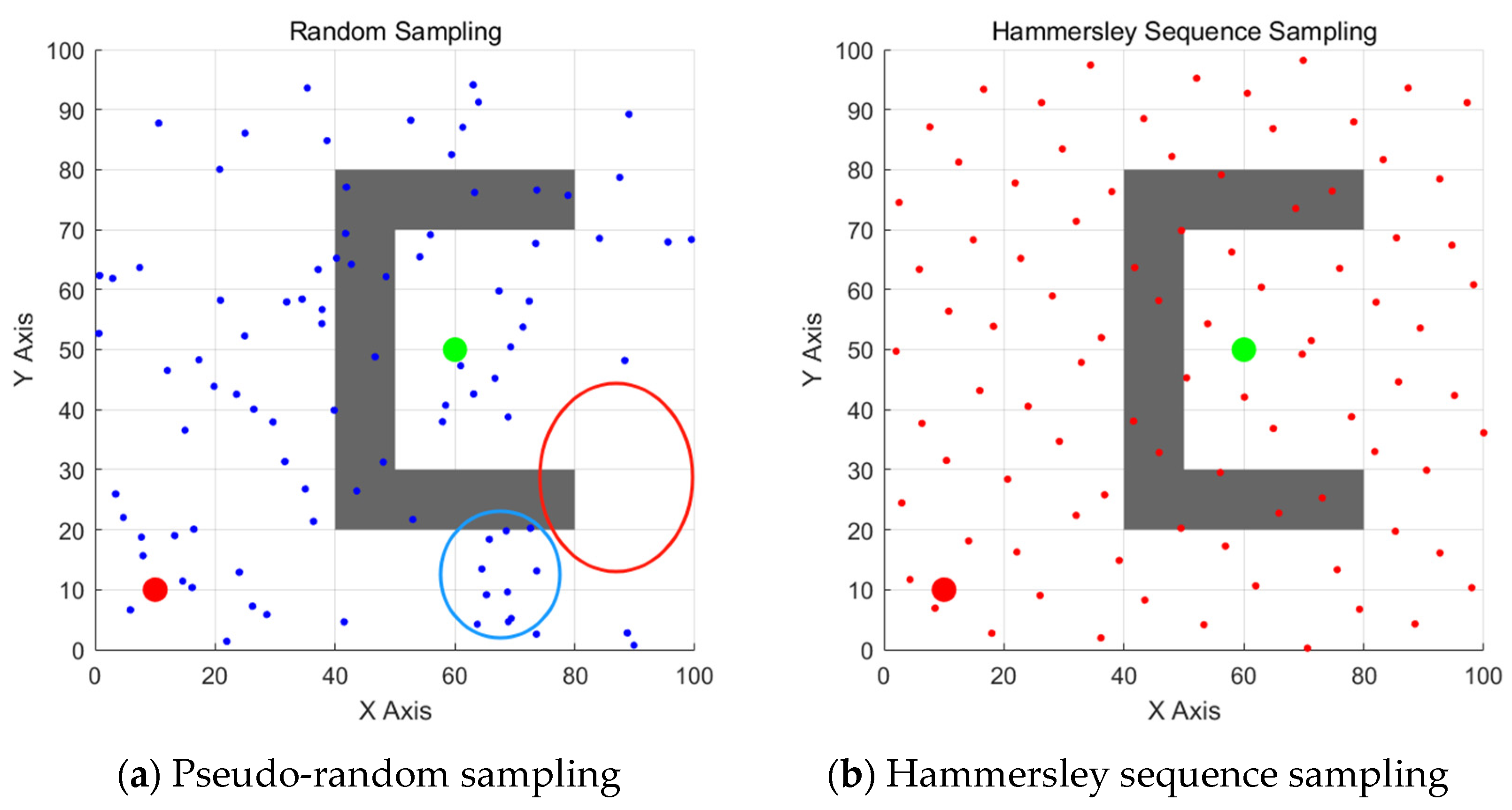


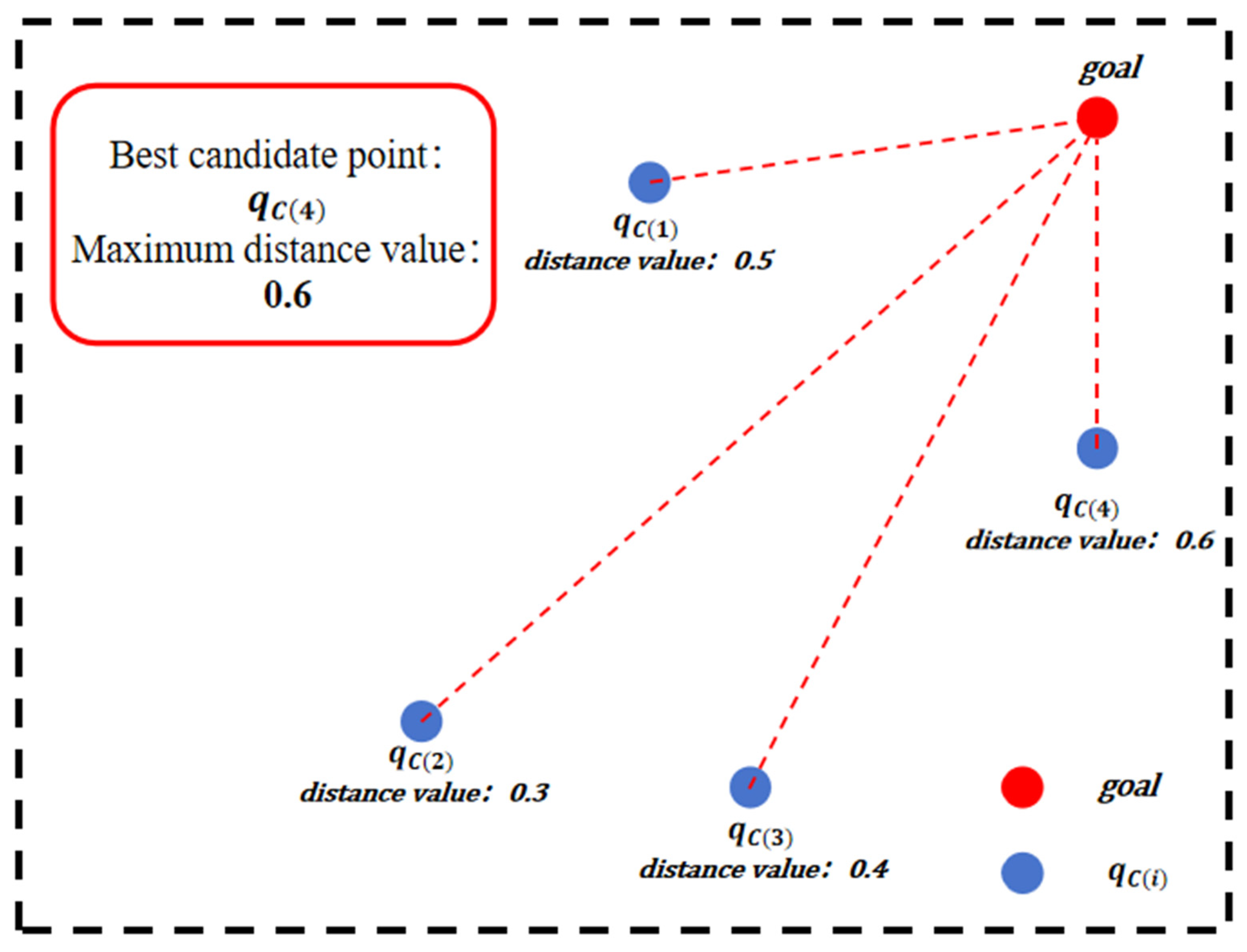
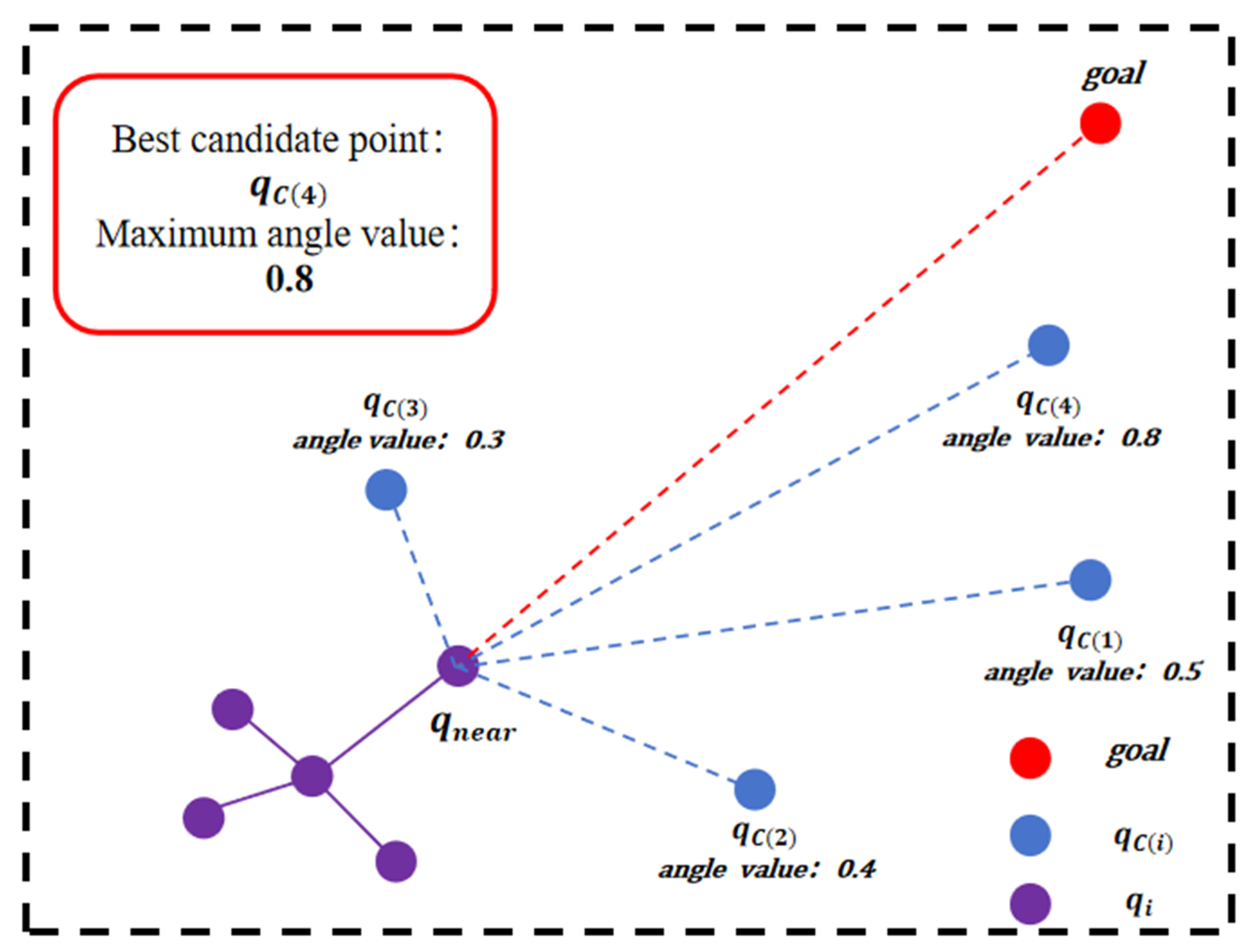

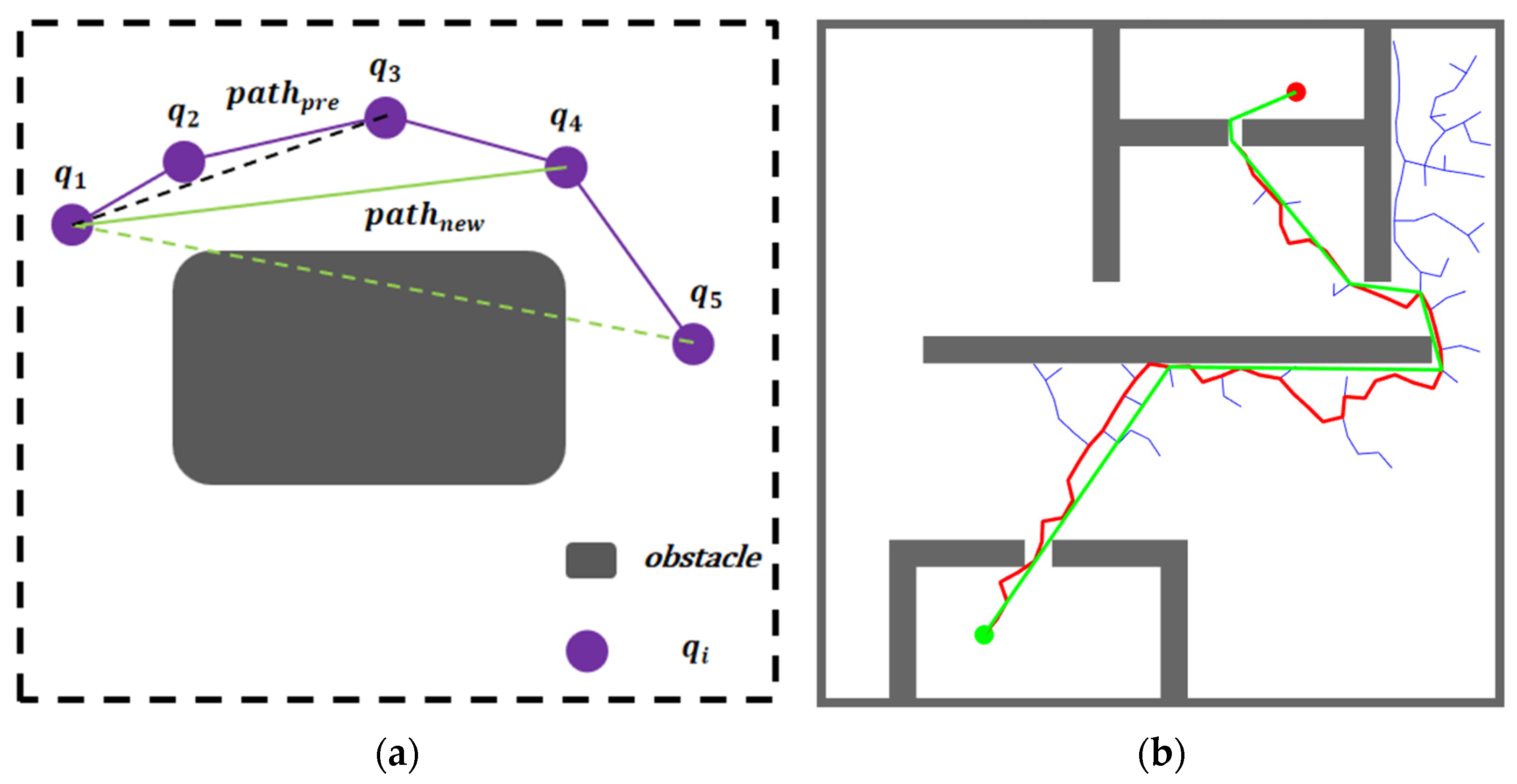



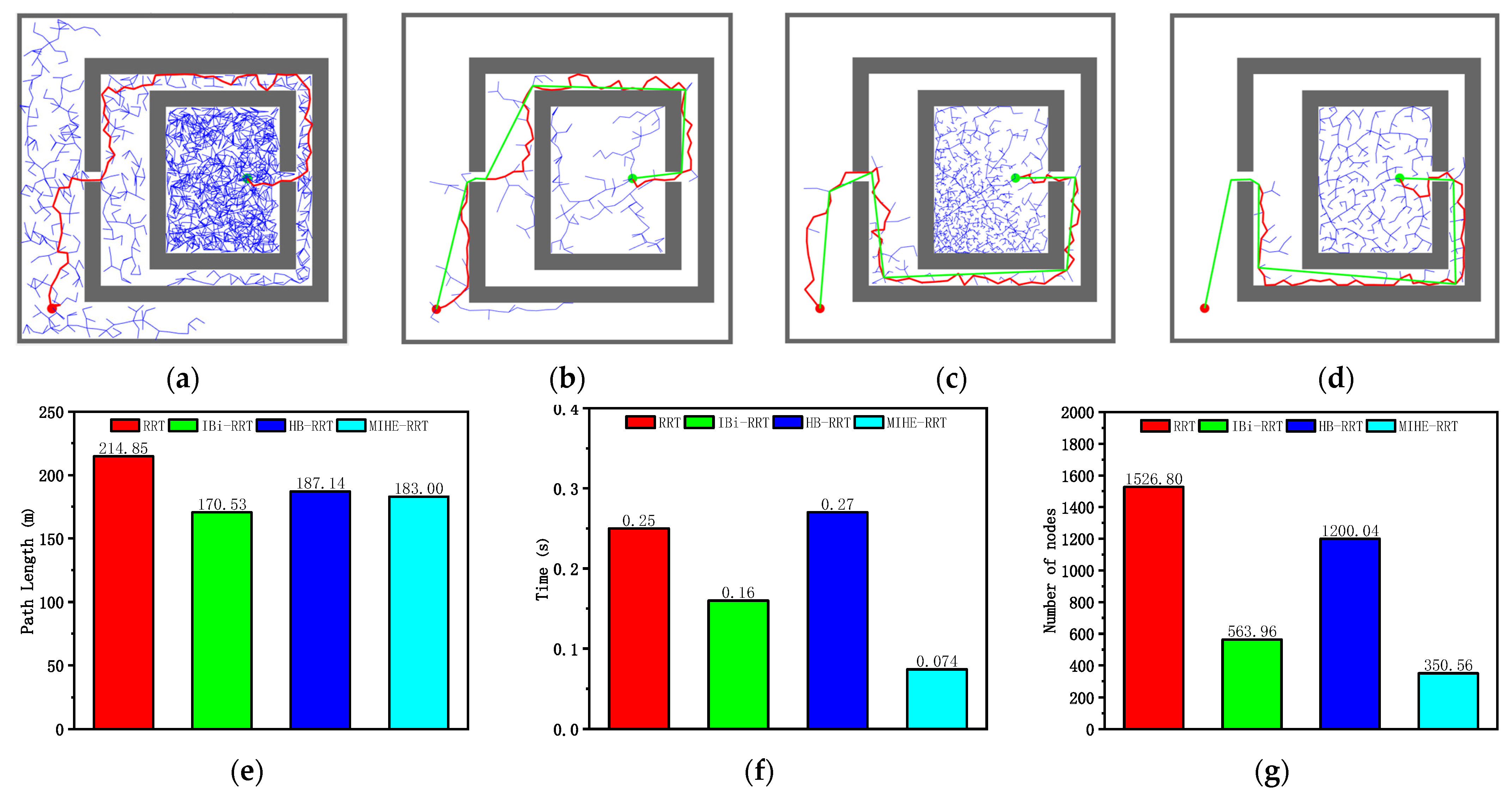
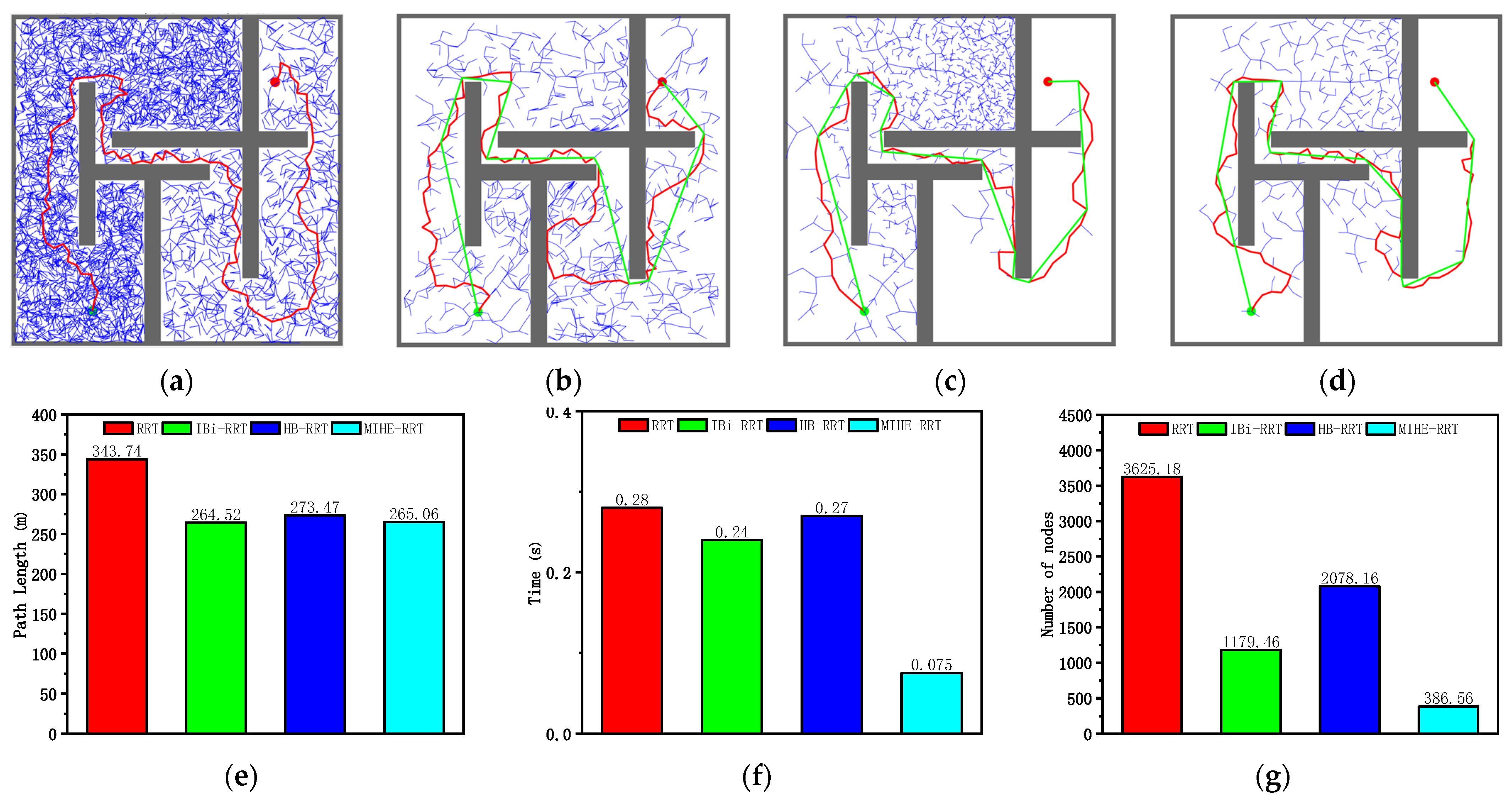

| Algorithm | Sampling Method | Heuristic Strategy | Path Optimization |
|---|---|---|---|
| RRT | Pseudo-random sampling | None | None |
| RRT* | Pseudo-random sampling | Cost function | Rewiring |
| Informed-RRT* | Elliptical region sampling | Heuristic ellipse | Rewiring |
| IBi-RRT | Pseudo-random sampling | Random node preferential selection strategy and adjustable attraction magnitude strategy | Quadratic B-spline curve smoothing algorithm |
| HB-RRT | Halton sequence | Goal-directed strategy and candidate pool strategy | Multi-level planning algorithm |
| Neural RRT* | CNN-guided sampling and pseudo-random sampling | Neural network prediction | None |
| MIHE-RRT | Hammersley sequence | Multi-indicator heuristic evaluation mechanism | Tree pruning algorithm |
| Path Length (m) | Time (s) | Number of Nodes | |||
|---|---|---|---|---|---|
| 0.6 | 0.1 | 0.3 | 167.56 | 0.041 | 169.63 |
| 0.8 | 0.1 | 0.1 | 162.33 | 0.046 | 200.05 |
| 0.4 | 0.5 | 0.1 | 174.95 | 0.054 | 177.72 |
| 0.4 | 0.4 | 0.2 | 175.66 | 0.064 | 275.46 |
| 0.4 | 0.3 | 0.3 | 165.99 | 0.068 | 289.85 |
| N | Path Length (m) | Time (s) | Number of Nodes |
|---|---|---|---|
| 10 | 187.54 | 0.036 | 413.79 |
| 15 | 178.55 | 0.034 | 297.11 |
| 20 | 178.81 | 0.037 | 263.72 |
| 25 | 173.29 | 0.036 | 211.13 |
| 30 | 172.16 | 0.044 | 209.29 |
| 35 | 171.41 | 0.044 | 182.91 |
| 40 | 170.48 | 0.071 | 232.97 |
| Algorithm | Environment | Parameter | Minimum | Maximum | Mean | Improvement |
|---|---|---|---|---|---|---|
| RRT | Semi-closed | Path length (m) | 130.93 | 219.71 | 150.39 | 24.02% |
| Time (s) | 0.0074 | 0.052 | 0.021 | 54.76% | ||
| Number of nodes | 216 | 1685 | 631.34 | 94.30% | ||
| IBi-RRT | Semi-closed | Path length (m) | 109.73 | 166.067 | 122.23 | 6.52% |
| Time (s) | 0.01 | 0.095 | 0.012 | 20.83% | ||
| Number of nodes | 152 | 315 | 210.10 | 82.87% | ||
| HB-RRT | Semi-closed | Path length (m) | 113.93 | 126.99 | 118.70 | 3.74% |
| Time (s) | 0.0022 | 0.72 | 0.013 | 26.92% | ||
| Number of nodes | 45 | 126 | 80.16 | 55.09% | ||
| MIHE-RRT | Semi-closed | Path length (m) | 110.61 | 121.76 | 114.26 | - |
| Time (s) | 0.0077 | 0.012 | 0.0095 | - | ||
| Number of nodes | 26 | 58 | 36 | - |
| Algorithm | Environment | Parameter | Minimum | Maximum | Mean | Improvement |
|---|---|---|---|---|---|---|
| RRT | Maze | Path length (m) | 196.23 | 236.68 | 214.85 | 14.82% |
| Time (s) | 0.12 | 0.58 | 0.25 | 70.40% | ||
| Number of nodes | 812 | 3190 | 1526.8 | 77.05% | ||
| IBi-RRT | Maze | Path length (m) | 164.77 | 180.75 | 170.53 | −7.31% |
| Time (s) | 0.14 | 1.09 | 0.16 | 53.75% | ||
| Number of nodes | 274 | 2220 | 563.96 | 37.87% | ||
| HB-RRT | Maze | Path length (m) | 177.45 | 198.49 | 187.14 | 2.21% |
| Time (s) | 0.05 | 1.37 | 0.27 | 72.59% | ||
| Number of nodes | 538 | 3199 | 1200.04 | 70.81% | ||
| MIHE-RRT | Maze | Path length (m) | 176.36 | 188.06 | 183 | - |
| Time (s) | 0.036 | 0.23 | 0.074 | - | ||
| Number of nodes | 189 | 1029 | 350.36 | - |
| Algorithm | Environment | Parameter | Minimum | Maximum | Mean | Improvement |
|---|---|---|---|---|---|---|
| RRT | Chaotic | Path length (m) | 299.54 | 388.78 | 343.74 | 22.89% |
| Time (s) | 0.21 | 0.43 | 0.28 | 73.21% | ||
| Number of nodes | 2724 | 5170 | 3625.18 | 89.34% | ||
| IBi-RRT | Chaotic | Path length (m) | 249.77 | 304.94 | 264.52 | −0.20% |
| Time (s) | 0.13 | 1.63 | 0.24 | 68.75% | ||
| Number of nodes | 668 | 2734 | 1179.46 | 67.23% | ||
| HB-RRT | Chaotic | Path length (m) | 253.36 | 297.83 | 273.47 | 3.08% |
| Time (s) | 0.1 | 0.63 | 0.27 | 72.22% | ||
| Number of nodes | 1264 | 3603 | 2078.16 | 81.40% | ||
| MIHE-RRT | Chaotic | Path length (m) | 248.99 | 292.69 | 265.06 | - |
| Time (s) | 0.057 | 0.12 | 0.075 | - | ||
| Number of nodes | 313 | 608 | 386.56 | - |
| Algorithm | Environment | Parameter | Minimum | Maximum | Mean | Improvement |
|---|---|---|---|---|---|---|
| RRT | Crowded | Path length (m) | 173.06 | 232.94 | 191.12 | 18.71% |
| Time (s) | 0.06 | 1.00 | 0.26 | 87.69% | ||
| Number of nodes | 636 | 9857 | 2888.02 | 93.84% | ||
| IBi-RRT | Crowded | Path length (m) | 125.86 | 172.94 | 143.09 | −8.57% |
| Time (s) | 0.05 | 1.24 | 0.16 | 80% | ||
| Number of nodes | 146 | 1767 | 514.46 | 65.46% | ||
| HB-RRT | Crowded | Path length (m) | 160.32 | 199.69 | 171.31 | 9.31% |
| Time (s) | 0.016 | 0.18 | 0.051 | 37.25% | ||
| Number of nodes | 106 | 561 | 291.73 | 39.09% | ||
| MIHE-RRT | Crowded | Path length (m) | 147.63 | 168.76 | 155.36 | - |
| Time (s) | 0.016 | 0.13 | 0.032 | - | ||
| Number of nodes | 84 | 664 | 177.71 | - |
Disclaimer/Publisher’s Note: The statements, opinions and data contained in all publications are solely those of the individual author(s) and contributor(s) and not of MDPI and/or the editor(s). MDPI and/or the editor(s) disclaim responsibility for any injury to people or property resulting from any ideas, methods, instructions or products referred to in the content. |
© 2025 by the authors. Licensee MDPI, Basel, Switzerland. This article is an open access article distributed under the terms and conditions of the Creative Commons Attribution (CC BY) license (https://creativecommons.org/licenses/by/4.0/).
Share and Cite
Wu, W.; Kong, C.; Xiao, Z.; Huang, Q.; Yu, M.; Ren, Z. Multi-Indicator Heuristic Evaluation-Based Rapidly Exploring Random Tree Algorithm for Robot Path Planning in Complex Environments. Machines 2025, 13, 274. https://doi.org/10.3390/machines13040274
Wu W, Kong C, Xiao Z, Huang Q, Yu M, Ren Z. Multi-Indicator Heuristic Evaluation-Based Rapidly Exploring Random Tree Algorithm for Robot Path Planning in Complex Environments. Machines. 2025; 13(4):274. https://doi.org/10.3390/machines13040274
Chicago/Turabian StyleWu, Wenqiang, Chuixin Kong, Zhongmin Xiao, Qianping Huang, Mingfeng Yu, and Zhiye Ren. 2025. "Multi-Indicator Heuristic Evaluation-Based Rapidly Exploring Random Tree Algorithm for Robot Path Planning in Complex Environments" Machines 13, no. 4: 274. https://doi.org/10.3390/machines13040274
APA StyleWu, W., Kong, C., Xiao, Z., Huang, Q., Yu, M., & Ren, Z. (2025). Multi-Indicator Heuristic Evaluation-Based Rapidly Exploring Random Tree Algorithm for Robot Path Planning in Complex Environments. Machines, 13(4), 274. https://doi.org/10.3390/machines13040274








